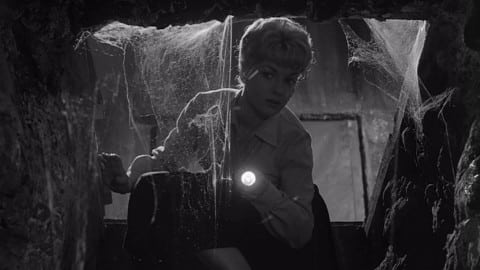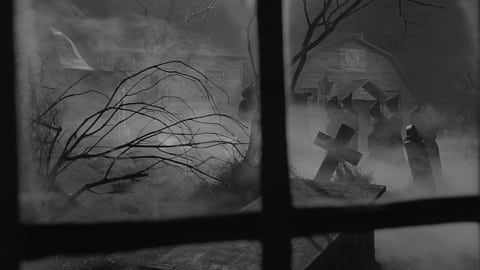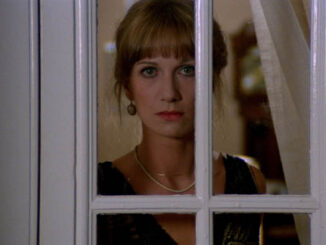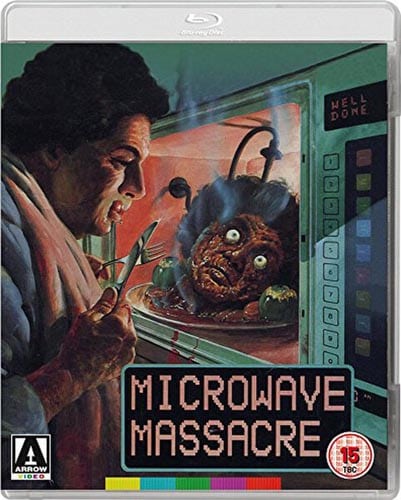The City of the Dead (1960)
Directed by: John Llewellyn Moxey
Written by: George Baxt, Milton Subotsky
Starring: Christopher Lee, Dennis Lotis, Patricia Jessel, Tom Naylor
AKA HORROR HOTEL
UK
AVAILABLE ON DUAL FORMAT BLU-RAY AND DVD: 24th April, from ARROW VIDEO
RUNNING TIME: 78 min/ 76 min
REVIEWED BY: Dr Lenera, Official HCF Critic
In 1692, just before accused witch Elisabeth Selwyn is burned at the stake in Whitewood, Massachusetts, she appeals to compatriot Jethrow Keane for help, and Lucifer intercedes, causing a rainstorm. In the present day, history professor Alan Driscoll advises student Nan Barlow that she spend her time in Whitewood and do some research of witchcraft there. He originally came from there, so he also recommends she stay at The Raven’s Inn run by a Mrs. Newless. Despite the objections of boyfriend and fellow-student Bill Maitland, and her brother and science professor Richard Barlow, Nan sets off, picks up a hitchhiker who vanishes as soon as they arrive at Whitewood, and meets Mrs. Newless and the blind local Reverend Russell who says to her: “Leave Whitewood tonight, leave before it’s too late”….
This highly atmospheric horror movie, which has more than a whiff of both Val Lewton and H. P. Lovecraft about it, is a minor classic from a period comprising the late 1950’s to the early 1960’s where Britain really was going through a great horror phase [though the BBFC regarded it to be anything but great]; not only did you have the classics from Hammer but you also had Peeping Tom, Horrors Of The Black Museum, The Flesh And The Fiends, Night Of The Eagle and several others. I recall finding it pretty chilling when I first watched on TV but never bothered to obtain it on video or DVD as for a while it seemed to turn up on TV quite regularly and I would always watch it. It’s first half is almost a tour de force of foreboding eeriness in which the black and white photography and even the low budget are assets. If you’ve not seen the film but heard of it, you’ll probably already know that its story is constructed in a manner very similar to that of Psycho, though this film actually came out first [though I suppose the screenwriters may have read Robert Bloch’s novel]. The rest of the film isn’t on quite as high a level as the first half, but still has some imaginative touches and even has a reasonable amount of intelligence about it. It may also have influenced City Of The Living Dead and two particular Dario Argento movies.
Considering that it was produced by Milton Subotsky and Max Rosenberg, The City Of The Dead can pretty much be considered as the first film from Amicus, who later became Hammer’s major rival in the British horror stakes with films like Dr. Terror’s House Of Horrors and The Skull to their name, though the duo called themselves Vulcan Productions here. The script was originally written by George Baxt as a pilot for a proposed TV series starring Boris Karloff. When that failed to get off the ground, Subotsky rewrote it to be longer, notably adding the character of Bill, the boyfriend who goes looking for Nan after she goes missing. It was shot entirely at Shepperton Studios with an almost entirely British cast who were required to speak with American accents throughout. The extensive fog was created by paraffin which made cast and crew cough very often. The film, double billed with Roger Corman’s I Mobster, did disappointing business though its tiny budget ensured that it did make a small profit. It wasn’t released in the US until 1963 where it was double billed with the schlocky German sci-fi/horror The Head. The title was changed to Horror Hotel and the film shorn of two minutes, removing much of Elisabeth’s cursing at the beginning and some later dialogue about the supernatural. If this was at the behest of the MPAA, than it’s very odd, but then censors are odd and certainly inconsistent folk. Arrow’s Blu-ray of the film has been rated ‘15’, which means that it’s considered to be far less suitable for children than The Curse Of Frankenstein – and that’s strange.
A brazier burns on the left hand side of the screen in a stunning opening shot as figures materialise out of the fog on the right hand side to condemn Elisabeth the witch to death [did Mario Bava see this before making Black Sunday?], who’s initially defiant, than terrified and helpless as she starts to be burnt at the stake. We don’t see anything graphic, but quite a bit of time is spent with her as the flames begin to reach her skin and we even get a torch thrust right into the camera. The villagers crying “burn witch, burn witch” nicely cuts to Alan saying the same thing as he relates the story in modern times to his student Nan. There’s then an interesting discussion between Richard [no actor can say lines like “witchcraft is not nonsense” with as much gravitas as Christopher Lee] and fellow professor Richard who scoffs at Alan’s suggestion that witchcraft could have basis in fact and that “The basis of fairy tales is reality, the basis of reality is fairy tales”. Nan still heads off for Whitewood, stopping briefly at a service station to ask for directions and be told: “not many God-fearing folk visit Whitewood these days”, then to pick up a hitchhiker suddenly appearing in the middle of the fog-strewn road who happens to look just like Jethrow, Elisabeth’s aide back in 1692. Once at their destination, the man disappears, and Nan is at one of the spookiest villages in horror movie history, its black and rotting buildings forever surrounded by deep fog in which a villager or two occasionally walks about to stare, and with perpetual darkness from the sky above. It’s little more than one basic set of a main square with a graveyard on one side, but it really does the job in pulling the viewer into a strange and forbidding world where you just don’t know what’s real and what isn’t and I was really impressed, watching it with more critical eyes, how well the film did this!
The owner of the hotel Mrs Newless is the spitting image of Elisabeth so seeing her talk about certain “festivities” is hardly giving the game away too early. What with the local Reverend [who has no congregation] telling her to leave and the mute hotel cleaner obviously trying to warn her off too, it’s a wonder that Nan doesn’t leave almost immediately, but then this is a horror film. It’s all quite eerie as chanting seems to emit from beneath Nan’s room, her locket mysteriously disappears, and dancing is heard downstairs but when Nan enters there’s nobody there. Things do significantly go down a notch or two when the focus changes to Patricia, who’s the granddaughter of the Reverend, and Bill and Richard investigating Nan’s disappearance, and even first time viewers may know where the story’s going, but there are a couple of reasonable surprises. The fact that Alan is also in league with the forces of darkness doesn’t come as one of these surprises though because he’s played by Lee, and it’s kind of amusing that nobody picks up on his slightly sinister reactions. And there are inconsistencies here and like, like the nature of Elisabeth’s power. A few details of the basic story are left rather vague, though in a film of this nature this can be something of a bonus. The fact that, for example, most of the faces in the opening scene turn up later in the present day, is rather unsettling, even if we’re not told whether they’re ghosts, hundreds of years old, reincarnations, or something else. It just works.
Violence and gore are extremely muted. There’s a slightly grim strangulation and a couple of shots of birds with arrows through them, but the most potentially brutal killing occurs off screen [though it employs a superb edit from a knife about to enter human flesh to another knife cutting a birthday cake] and if it wasn’t for the presence of Lee you’d probably think that this film was made twenty or so years before it actually was – which is not necessarily a bad thing. The finale, which may or may not have borrowed a gimmick from The Brides Of Dracula [it was shot before that film but released afterwards], isn’t the most convincing of scenes, and after seeing those gravestones a few times it’s very obvious that they’re cardboard, but in general this film is an example of how something entirely studio bound can cast its own unique spell. The variable American accents bring their own aspect of unreality to the proceedings. Lee, who doesn’t have much screen time [but then he never did as Dracula either], actually does better than some of the other cast members, but the only really convincing and indeed authentic accent is from James Dyrenforth who sounds properly New England. Performance-wise it’s really Patricia Jessel as Elisabeth who’s really the star of the show. She suggests an underlying depravity yet also has a certain elegance which is just right. The three other leading ladies are refreshingly un-bimbo like, though Venetia Stevenson gets a rather gratuitous underwear scene.
After just one more film the director John Llewellyn Moxey spent the rest of his career on TV movies and series episodes. These sometimes had a macabre aspect, but it’s a shame that he didn’t go on to make cinema-intended films, and like this, because it seems to have a real feel for the Gothic. Desmond Dickinson’s lensing provides some excellent compositions – there’s one hauntingly beautiful one of hooded figures passing into the village – and lots of film noir style lighting, often in deep focus. On the other hand Douglas Gamley’s music, even though it begins effectively with Latin Black Mass incantations over the opening titles, is otherwise either mediocre or a little out of place with its jazz elements, though it’s probably a decent listen for score fans outside of the movie. I have a feeling that some newcomers to The City Of The Dead may not be too impressed by it because most of its plot elements have been rehashed over and over again since, but this wouldn’t have been the case when it first came out. A film quite unlike most of the other horrors that were coming out at the time [only Night Of The Eagle has some real similarities], this British partial throwback to an even more vintage period of cinematic terror is consistently interesting and will probably stick in the mind for some time.
Rating: 









The Region ‘A’ VCI Blu-ray of The City Of The Dead was criticised for looking waxy and showing obvious signs of digital tampering. It was even in the wrong ratio! Arrow’s disc sets things right with a gorgeous restoration from the BFI and the Cohen Film Foundation. Everything looks natural and yet also so deep, the transfer handling the extensive black with no crushing. In terms of special features this set is a winner too. Even if only one of the extras is new, it’s a great one, an audio commentary [replacing another in the Region ‘A’ disc] by Jonathan Rigby who might be familiar from other releases of similar films, and whose book English Gothic is one of the very best on the subject. He never stops for breath and actually seems to have trouble cramming in all the information he has at his disposal, but has a slight droll manner which prevents things from getting too dry. This is followed by an older commentary I probably enjoyed even more with Lee and, struggling to get a words in edgeways, horror film writer Jay Slater. I could listen to Lee all day with that incredible voice, intellect and memory, so it didn’t bother me that around half way through he started to talk more about other things like actor’s working hours, or said that he hated splatter movies. He seems to like the film which he hasn’t seen since 1960, though for some reason he’s watching it with no sound and therefore trying to work out what’s happening – odd, since you can hear the film’s soundtrack in the background when you actually listen to this commentary. And finally [three commentaries!] you have Moxey who sadly seems to remember little and just adds observations here and there. It’s not totally redundant, but you learn very little.
So onto the other special features which are from the 2001 VCI DVD, and first up is the alternate US version Horror Hotel missing those couple of minutes of dialogue. I watched bits of it and both the story and its themes are slightly murkier with the removal of just two minutes. Then we have a 45 minute interview with Mr Lee, and the poor interviewer [Brad Stevens, another good writer about films] only manages to get in three or four questions because Lee goes into so much detail and goes off on tangents, but who cares? This is the legend who is Christopher Lee, let him talk as much as he likes! He tells some great stories about some of the directors he’s worked with [while he certainly admires Terence Fisher, he regards Billy Wilder as the best], rightfully criticises the British film industry, tells us that he initially turned down every single one of his Dracula films after the first two [this Hammer fan thought it was just two of the films] as well as reminding us that in 2001 [when this interview was shot], a remake of The Devil Rides Out was planned with Joe Dante directing [I like Dante, but – no!!]. There’s a ‘behind the scenes’ addition to this interview, and honestly, to this critic, who’s been a Lee fan since he was about 8 years old, it was both heaven and a bit annoying that he hadn’t seen it [which was on the US DVD release from 2001] previously. The other guys are clearly in awe of him as he signs things and then talks [I’ve said this earlier, but I could listen to Lee all day] about various things, but in particular about the dreadful British press. If anyone reading this still believes that stuff you read in certain British tabloids is true, just listen to Lee talking about some crap they printed about him. After this, interviews with Moxley [who sounds far more Welsh then he does on the commentary] and Venetia Stevenson seem a bit disappointing, but are still worth checking out. Moxley provides some information which isn’t on his commentary , and Stevenson tells us that she didn’t know who Lee was before she made the film.
A great collection of special features to compliment a good slice of old school horror which, if you haven’t seen it, every fan of the genre should check out.
SPECIAL EDITION CONTENTS:
*New 4K digital restoration by the Cohen Film Collection and the BFI
*High Definition Blu-ray (1080p) and Standard Definition DVD presentations of two versions of the film: The City of the Dead and the alternative US cut, Horror Hotel
*Uncompressed Mono 1.0 PCM Audio
*Optional English subtitles for the deaf and hard of hearing
*Audio commentary by film critic Jonathan Rigby, author of English Gothic: Classic Horror Cinema 1897-2015 and Christopher Lee: An Authorised Screen History, recorded *exclusively for this release
*Audio commentary by director John Llewellyn Moxey
*Audio commentary by actor Christopher Lee
*Archive interview with John Llewellyn Moxey
*Archive interview with Christopher Lee, conducted by critic Brad Stevens
*Archive interview with actor Venetia Stevenson
*Trailer
*Reversible sleeve featuring original and newly commissioned artwork by Graham Humphreys
FIRST PRESSING ONLY: Illustrated collector’s booklet featuring new writing by Vic Pratt








Be the first to comment